Sujata Massey's Blog, page 4
February 9, 2024
Eating My Way Through Kerala, Half-Cup Portions Only
This post originally appeared on Murder Is Everywhere.

Friends, I am back in India. It turned out that my wonderful October-November visit to India was not fulfilling enough. During that two-week journey, I’d gathered the information to finish one Perveen mystery; but now I was itching to learn more about Kerala for a subsequent book. I’d also luxuriated in a few Ayurvedic massages that reduced my chronic neck pain and made me contemplate whether three weeks of daily treatment might cause the entire problem to go away.
I was still jet-lagged when an ad arrived in my inbox for a Black Friday airfare sale at Etihad Airways. Etihad is my favorite carrier to fly to India because it’s a straight flight from Washington’s Dulles airport to Abu Dhabi, and then less than 4 hours to a variety of cities in India: not just Delhi or Mumbai. I thought about it for a few days. And the morning after the turkey was roasted, I’d bought myself a round trip ticket for a 28-day visit to Kerala.
I arrived last Friday on a hot, sunny morning. I rode two hours in an air conditioned van to a village in the Alepuzzha district called Manannchery. Here lies Amal Tamara, a 5-star hotel that is also an accredited Ayurvedic hospital with a medical faculty, physical therapists, and its own pharmacy department.
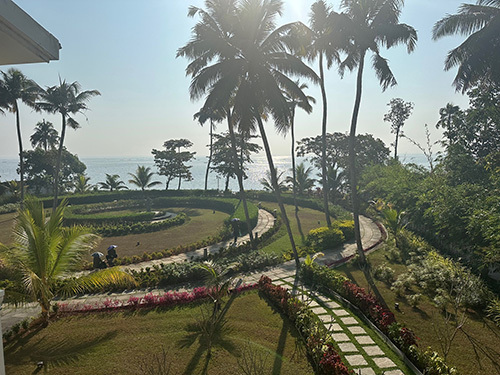 View from my balcony
View from my balcony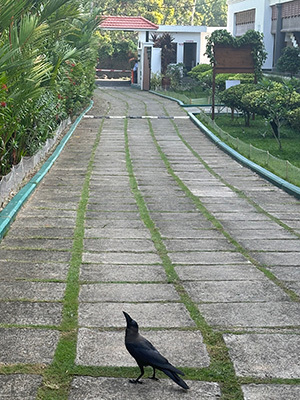 The entry to the facility
The entry to the facilityKerala sits at the southern tip of India, where the monsoon arrives first. This state gets the most rainfall of any location in India and is famous for its green fields, massive mountains, and a network of rivers and lakes known as the Backwaters. Perhaps because of the very high temperatures most months of the year, the people of Kerala developed a pattern of refreshing, oil-free cooking. Ayurveda, the ancient medical system of India, began in the north, but it’s said that eight saints traveled south and brought their wisdom to Kerala, where Ayurveda took root more deeply. Throughout the state, hundreds of public and private hospitals and hotel resorts offer massages with medicated oils and powders and special herbal prescriptions. The safest places are certified by a national board of Ayurvedic medicine.
Another aspect to Ayurveda treatment is following a daily diet based on one’s grouping in three general body/constitution types: Vata, Pitta and Kappa. Food can be used to support one’s personal affinities and also vulnerabilities. Many people follow these food principles at home using books and advice from their Ayurved, as the doctors are called. However, staying at Ayurvedic facility gives people a chance to taste a whole lot of interesting and healthy Indian food and not to have to worry about cooking. Everything is customized and served; unlike a regular hotel, one doesn’t make choices about portion or type of food. After all, food is medicine.
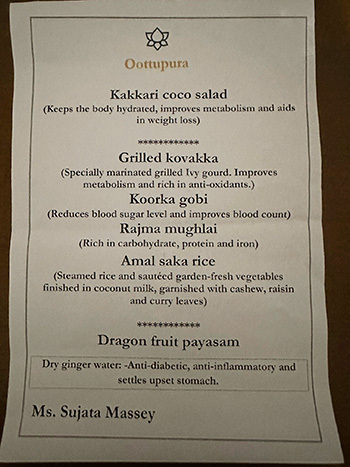 A lunch
A lunch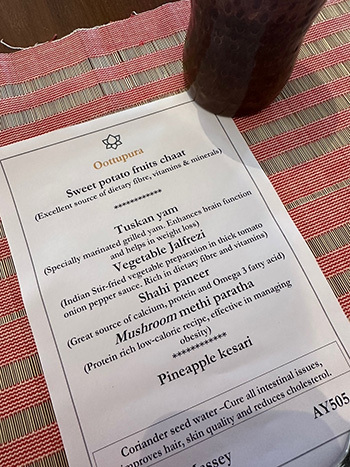 Another Lunch
Another LunchSome samples of my personal prescribed menus are above. Each time I come to my table (dining in silence without use of devices is encouraged), a cup of warm water arrives in a copper cup along with my menu. A serving of two vazhakoomvu tikka, perfectly crispy banana-flower fritters, is “rich in fibre and protein, effective in treating infection and shows down the aging process.” Idichu thalichathu, stir-fried yam with crackled mustard seed and curry leaves, “enhances brain function and helps in weight loss.” Cheera Mappas, sautéed red spinach in coconut coriander gravy, “restores energy, improves vitality and blood count.” Promises, promises! If I live here forever, does it mean I’ll always be alive?
The food served is so varied that it’s quite likely a person is eating 40 different plant foods a day. Maybe more. And I appreciate the novelty of the ingredients which are rarely seen at upscale Indian restaurants. Yams, Ivy gourd, and drumsticks might not sound exciting—but these popular home-grown Kerala vegetables are when shared in traditional and fusion recipes. You wash all this deliciousness down with glasses of warm water flavored with a different beneficial spice every day. I’ve had cumin, coriander, dry ginger and cardamom water so far, and the taste is quite subtle.
So what’s off the table? Meat, fish, salt, oil, refined sugar, white rice and white flour, caffeinated tea and coffee, and alcohol. Even though I know I’ll taste these foods again some time, I’m not craving them. These Ayurvedic dishes are so prettily presented and tasty, that one forgets. And while portion sizes are petite, the fiber content is high enough that I’m only hungry before breakfast. There are no machines with snacks if you get hungry in the wee hours or have that restless boredom that leads to thinking about a quick bite. But I confess to stockpiling some of the delicious peanut burfi and sesame jaggery balls that Amal Tamara provided for me in the car that came to Kochi International Airport. My four remaining “Healthy Bites” were devoured the first time I woke up at 3:30 am. I’m still awakening far too early, so the doctor kindly allowed me to have apples and bananas in the room. We take our prescribed medicines at 7:30, after sunrise yoga, and we eat breakfast at 8, lunch at 1, and dinner at 7. There are only about a dozen guests here—it’s a small hotel—so we are getting to know each other well during this moment of pursed lips and grimaces.
Food as medicine is a much happier moment of the day.
 Chef Ardesh and food and beverage manager Tony
Chef Ardesh and food and beverage manager Tony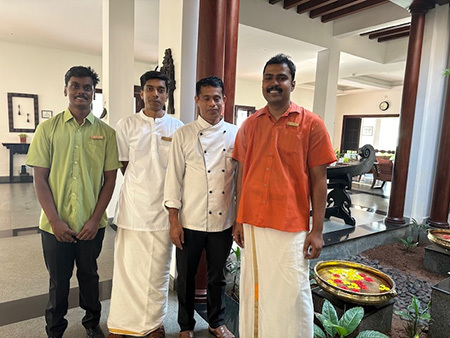 The breakfast culinary and service team
The breakfast culinary and service teamBreakfast always starts with fruit and continues with some protein, often a South Indian favorite like dosa or uppma.
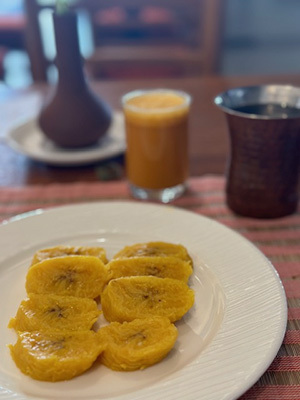 First course for a breakfast: steamed bananas
First course for a breakfast: steamed bananas Breakfast course two: ragi dosa, sambar, beet chutney
Breakfast course two: ragi dosa, sambar, beet chutney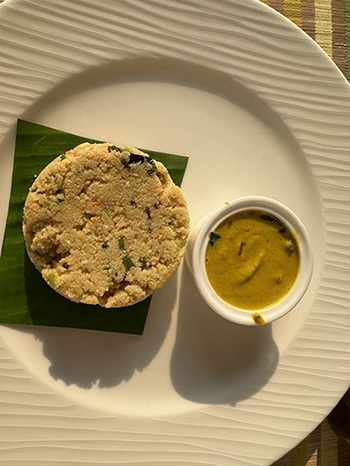 Another breakfast: uppma and turmeric chutney
Another breakfast: uppma and turmeric chutneyLunch is always the biggest meal; it comes with a starter and dessert.
 Sweet potato and fruit chaat appetizer
Sweet potato and fruit chaat appetizer Pumpkin-leaf thoren, lauki kofta, dal with beet and coconut rice
Pumpkin-leaf thoren, lauki kofta, dal with beet and coconut rice Yam, veggie jalfrezi, paneer in cashew gravy, and mushroom methi paratha
Yam, veggie jalfrezi, paneer in cashew gravy, and mushroom methi paratha A tiny sweet dessert: Pineapple kesari and a grape
A tiny sweet dessert: Pineapple kesari and a grape Lentil soup and banana blossom fritters with coriander chutney
Lentil soup and banana blossom fritters with coriander chutney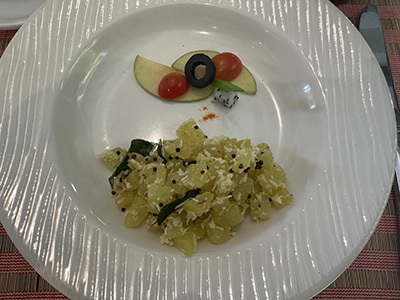 Papaya-coconut curry with a whole wheat chapati
Papaya-coconut curry with a whole wheat chapatiDinner is often a pureed soup followed by a vegetable dish, a flatbread and… no dessert.
And speaking of sweets, one of my massage therapists, Nithu, chatted about her young son’s birthday celebration a few days earlier. His school has a rule forbidding the kids’ families to bring a cake or candy to school. Instead, parents are encouraged to send a bag of vegetables. These vegetables are cooked by a school chef into a healthy curry served to the class for the birthday celebration.
A clever idea, at least from the grownups’ point of view.
The post Eating My Way Through Kerala, Half-Cup Portions Only appeared first on Sujata Massey.
January 10, 2024
The Bookcase Rebellion
This post originally appeared on Murder Is Everywhere.

The Amazon-owned Washington Post recently reported on a poll by The Economist/YouGov on people’s reading habits.
Forty-six percent of people living in the United States read no books last year. Just five percent read one book. This book reading rate was about the same as when I began my writing career in the 1990s. Apparently, the top one percent in the survey were people who read 50 books or more a year. I know los of these people. Truthfully, I probably read thirty books a year, which ranks as the 88th percentile.
The public indifference to books makes the existence of the publishing industry—and advances paid for some flashy books—utterly bizarre. People don’t naturally turn to books for fun, no matter how hard we writers wish to entertain, comfort, provoke, or inform.
But I love writing. And one side effect of being a writer is it the accumulation of printed matter. Whenever I have a book published, I’m gifted 25 free copies from the US publisher—and at least 5 copies on average from the foreign publishers who choose to translate one of my books. This means several hundred of the books in the house are my own; volumes I’m not likely to be rereading. So why do I keep them? Why, for all the right reasons. I give them away to people who help me with my work, relatives, and the special person who’s able to read a Rei Shimura novel in German or a Perveen Mistry book in Korean. And looking at them on the shelf is a reminder that no matter how much I’m struggling, I can get a book written.
But my own works are probably only five percent of what’s stored in the house. Even though I regularly purge, I have overstuffed bookcases, a common situation for someone who loves to read and write. I coddle the books I’ve loved by housing them carefully with the intent of rereading. Yet so many new books come into my life each year that I rarely reopening a loved book.

I have written about decluttering books before—my journeys hauling books to Little Book Libraries around town, to the drop-off point for Books for Africa, to the loading dock for the Maryland Book Bank, and also to used bookstores, before so many of them went out of business.
This past weekend I looked at my shelves and saw how they were overflowing. So I took a deep breath and brought down some boxes to load up and take to the Maryland Book Bank, which is just a couple of miles away. This felt like my harshest purge ever. I took away books that I consider excellent, often saving just my very favorite by a particular author. Some series, like those by friends Marcia Talley, Laura Lippman, and Lauren Henderson, remained intact. If you are a book person, you know how hard it is to break up a collection; even if the books aren’t being read anymore, they feel like family members who want to stay.
This time around, I am looking at things from a different perspective: that of the built-in bookcases that flank my dining room entrance. The narrow bookcases, clearly added by some do-it-yourselfer many decades ago, make up a total of 32 shelves rising almost eight feet high. The bookcases seemed to be crying out to be treated with respect, not like a dumping ground.
Lately it’s seemed that my YouTube and Instagram feeds are packed with examples of beautiful bookcases, often painted in a bold color and wallpapered. They are serene spaces that show art and flowers and short runs of books, usually color-coordinated, or all looking vintage. Recently I stayed in a hotel where the bookcase in the suite held very old books—some dating from the late 1700s. The glamour of the curated bookcase has gone off the charts.

The people who style such bookcases probably aren’t ones who buy upwards of fifty books a year (yes, I buy more than I can possibly read). If it’s a year that I’m on a judging committee, between 150 and 500 books will be shipped to my house. Where do all my books live? Seven designated storage areas in the house (three studies, the living and dining rooms, the butler’s pantry, and a guest room). Oops, space eight is the floor next to my bed!
Recently, an interior designer walked through my home. I had invited her because of a vague feeling I want change in the house. The designer pointed out that there are too many visual elements pulling at the eye. She did not single out books—in fact, she kindly said, “books are the best thing” but she proposed a new bookcase for me. But before I jump to having this installed, I decided to see what I might do with the purge and making my own stab at styling a bookcase that included negative space. As I did the tedious work, hauling books here and there, alphabetizing others and making groupings for history, mystery, cooking and gardening, I took breaks to ponder how-to articles and peruse “beautiful bookcases” on the Internet. This made me decide to group my vintage cloth- and paper-bound volumes together. If I had a square book that didn’t fit the shelf, I faced it out. Bookcase styling is about judging a book by its cover. It’s a way of experiencing my own aged book collection as if I were shopping somewhere browsing books I’d like to own.

Some midlifers feel unfulfilled until they buy a luxury car. And then there are those who throw over their old partner for someone younger and hotter. Reinventing my dust-collecting bookshelves feels like a daintier rebellion. It’s my way of playing against tradition. I’m even thinking that in the next few months, the scarred white wooden shelves could be painted dark blue. Fabric on the back wall, or a decorative paper. And what about a few strategic spotlights?

The post The Bookcase Rebellion appeared first on Sujata Massey.
December 27, 2023
My Favorite Fun Streamable South Asian Shows of 2023
This post originally appeared on Murder Is Everywhere.
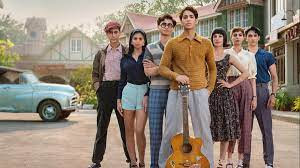
I’m more of a reader than a TV watcher, but the quality and creativity of films and episodic series just keeps rising. Of course, this lures me in. My special treat is the occasional binge on OTT content that’s either made in India or about the South Asian diaspora. During 2023, I found particular joy in these exhilarating, upbeat productions.
On Amazon Prime Video:

Made in Heaven, Season 2
This is a fictional series about Tara and Karan, two cool young wedding planners in Delhi who are also friends and, in this season, flatmates. The show is full of glitzy fashion and architecture, subtle humor, and loads of social awareness and romance. This is one of the few shows on my list where the English dubbing (done with Indian voices) is natural enough that you don’t need to watch in Hindi with subtitles. Each episode covers a freestanding story about a couple getting married. Tara and Karan both have personal dramas that started in Season 1, and there’s a whole ensemble of family and friends introduced, so it’s more understandable to watch the seasons in order.
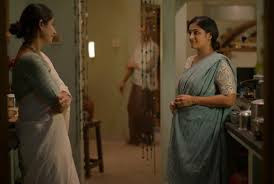
Modern Love Chennai.
The Modern Love series of film shorts is inspired by the essays made popular in the Sunday edition of the New York Times. Previous seasons of the Indian franchise of this show have been set in the cities of Hyderabad, Mumbai, and Delhi. This series is filmed in Hindi with subtitles in many languages, and no dubbing. Each episode is a standalone story, giving a nice feeling of satisfaction after the 45-minute episode finishes. Also, it’s great that the relationships explored in these filmed short stories are not all about young men and women headed toward matrimony. Love between parent and child, or between a mentor and young person, or between friends are all grist for this fantastic mill. This is not Bollywood song and dance—it’s the real scene in one of South India’s most dynamic cities.

Polite Society (also on Apple+, Google Play and YouTube)
Although this 104-minute film is set in Britain and is made by a British-Pakistani filmmaker, Nida Manzoor, it makes the list because it hilariously spoofs the striving community of Pakistani expats wanting excellent marriages for their children. Ria, a rough-and-tumble teenager, tries to save her artistic older sister Lena from willingly heading into arranged marriage with a hunky OB-GYN who seems too good to be true. Part martial arts action adventure, part kooky science fiction, and part family comedy, and my best laugh-out-loud film seen in 2023.
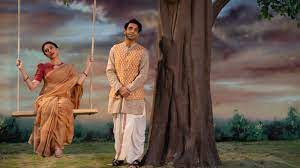
Jubilee
My appreciation for this historical series rocketed upward over the course of a few episodes. Set in the world of 1940s and 50s Bombay film world, Jubilee traces the destiny of three men and two women involved in acting and producing films. Their entanglements, including love affairs, violence, betrayal and legal suspense, are themselves a homage to the beloved tropes of Bollywood. But, oh—the gorgeous sets, cars and clothes, the stirring music, social worldview, and compelling acting! Stream it with subtitles or English dubbing, because the vocal track recorded by the show’s original actors is top notch.
On Netflix:

Sukhee
This 141-minute comedy about a young Punjabi housewife, her family and college friends falls into the realm of “women empowerment” cinema. There are good laughs and surprising directions taken, with some good song and dances. Of all the shows I’ve mentioned, this is the most stereotypically Bollywood, although the outcome is a pleasant surprise. This film isn’t dubbed, and it has subtitles.
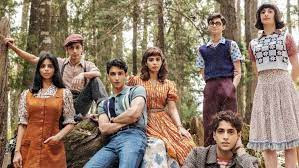
The Archies
The Archies puts Riverdale, the fictional location known to readers of Archie Comics, into North India. Specifically, up in a historic hill station populated since the early 1800s by a majority of Anglo-Indians, which gives a logical reason for the mostly fair-haired teenagers with names including Archie, Veronica, Betty, Reggie, and Ethel. I strongly advise against watching the dubbed version, which is Netflix’s standard setting for those of us streaming outside of India. The dubbed version is painful because it’s voiced by Americans which shatters the illusion of an Anglo-Indian community. Watch it in Hindi with English subtitles, and you won’t miss a beat.
The rollicking musical score brings Bollywood, Broadway and 1950s-60s pop, and the dances by the teens and the crowds around them are the best I’ve seen in a long time. The teenagers’ parents, especially Veronica’s borderline nefarious father, Mr. Lodge, also lend interest to the plot. A real estate crisis devised by Mr. Lodge is something that only Archie and the gang can solve—with a lot of songs and dance and a ’60s protest. If you liked Hairspray, Grease, or Barbie, you’ll adore The Archies. In fact, my adoration led me to stream it two times within the last twenty days.
On Hulu (and Apple):

India Bites
Chef Shrimoyee Chakraborty, a British Indian restauranteur, takes viewers to both Mumbai and her hometown of Kolkata to meet interesting people and get up close with food in this one-season program. The food is geared toward what a visitor might find in restaurants that reflects multiculturalism—such as the Persian-Indian mix of Parsi cuisine, the late night joys of Indo-Chinese bar food, and savory chaat snacks gobbled on the street. But this delightful series is not just about food; it’s hangout-interviews with people involved in acting, startup companies, and non-traditional romantic relationships. Stream this show before traveling to Mumbai or Kolkata, because it will give you a to-do list for sightseeing and eating. Recorded in English.
The post My Favorite Fun Streamable South Asian Shows of 2023 appeared first on Sujata Massey.
December 13, 2023
Marine Driven
This post originally appeared on Murder Is Everywhere.

It was just 4:30 in the morning when my husband Tony and I arrived in Mumbai on a middle-of-the-night flight from Kochi. I was tired, but not too tired to notice that Mumbai’s domestic terminal had really spiffed up its décor, restrooms and shops. It was easy to reach the baggage claim area where our suitcases had already arrived. This was quite different from waits of 30 minutes to an hour for baggage at some US airports recently. Luggage on a cart, we made our way down an escalator and while Tony was in the restroom, I approached a counter where one could pre-pay for licensed taxi rides.
I’d used the prepaid taxi service before from this airport, but it was an upgrade to find the booking counter in the air conditioned terminal. To my surprise, the dispatcher asked if I would accept having a “lady taxi driver.” It turned out that this was another innovation. After I heartily agreed and paid the fee, and he’d written down my destination on the voucher, Tony and I walked toward the taxi zone in the covered area for vehicles nearby. As we approached the designated parking spot, we heard a furious, yelling argument. Traveling deeper into the female cabdrivers’ zone, we found two women facing off and shaking fists at each other. One had short hair, a tight white T-shirt and jeans rolled to a cropped length ala James Dean, while the other had longer hair and wore an Indian kurti top and jeans. Their styles varied, but they both looked tough as hell. It was a sight straight out of a movie, but the gender of the players was a surprise.
The fight had drawn a lot of attention: not only the other lady drivers who were shouting encouragement to both sides, but also male taxi drivers who had deserted their parking spots to observe. Yet our designated driver was sound asleep in her car. After I knocked on the window, she groggily emerged, helped load the luggage, and took the voucher. As the taxi rolled out of the garage, the fighters parted, with peace in the garage restored.
We quickly sped off to the Hotel Intercontinental on Marine Drive. I longed to ask our driver if she knew the reason for the ladies’ fight, but the language gap was too vast. She was listening to our English conversation, though, and she chuckled at our surprise at the emptiness of the Bandra-Worli Sealink Road, which is usually packed. Because the sky was just lightening over the Arabian Sea, and the buildings were lit up, it made for spectacular views. Chalo! A car trip that normally might take one-and-a-half to two hours in daytime was just 35 minutes.
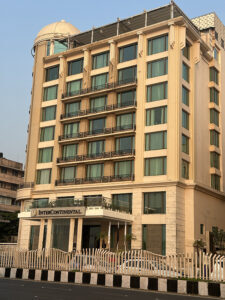
We pulled up to a small, cream-colored hotel with a curved side and glowing windows. This was the Intercontinental Marine Drive, our comfortable home for the next eight nights. I had been nervous about staying at a hotel that was not one of the city’s go-to big names, but I was delighted by the decor, service, and how small and manageable it was: just 59 rooms and eight stories high. Somehow, it felt more like staying in a nice condo building than a hotel.
Due to its location in the UNESCO-designated historic art deco district, the Intercontinental had to fit in with the surrounding 1930s neighbor buildings. Thus, the fully modern building was designed with one rounded side and a short turret on top, right next to the rooftop swimming pool. We stayed on the fifth floor, and the exterior of the suite was a long, curved wall of glass windows showing a triple-sided view of the water and Marine Drive. Standing in our room, gazing out at the breathtaking sunrise, I caught sight of a slowly growing number of people people jogging, walking, and doing group yoga and calisthenics. The Marine Drive promenade is bordered by a short wall that’s perfect for sitting; and here were many couples and student pals and retirees enjoying intimate time as the city woke up.
Truly, Marine Drive is the face of Mumbai you see in Bollywood rom-coms.

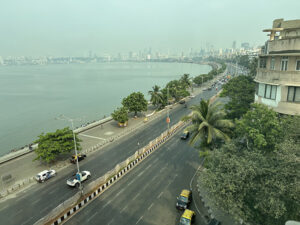
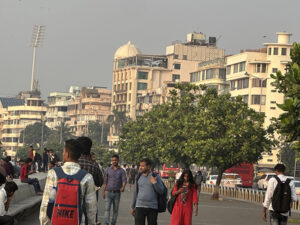
In my opinion, Marine Drive is one of the most beautiful places in Mumbai, but in the past, it was only a drive-by zone for me on the way to Malabar Hill or the Sealink. The district is a short distance from Colaba, Mumbai’s crowded tourist zone. No hawkers are here, also no tourists nor shops selling sandals and beads. Which makes it all the more relaxing.
The roadway was built in 1915-1920 from reclaimed land from Bombay’s Back Bay. Originally the roadway was called Kennedy Sea-Face Road in honor of Sir Michael Kennedy, the colonial officer who headed the city’s Public Works Department, but it was nicknamed the Queen’s Necklace because of the sparkling sight of street lamps along the bay, as viewed from the other side of the water.
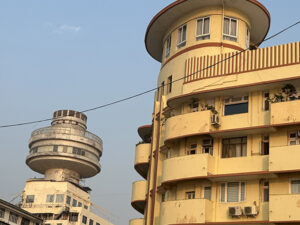
During the late 1920s and 1930s, the debut crop of young Indian architects wanted to dissociate themselves from the Gothic Saracenic architecture of colonialism. These architects were hired by developers wanting to create residential housing for the Indian elite on Marine Drive. What they designed were posh apartment buildings in the Art Deco style with a Bombay touch. As I wandered along the stretch, I saw the touch manifested in oddly shaped windows that looked like ancient Egyptian aesthetic eyes—or maybe ocean liner cabin windows with some extra trimming? And how about the turrets which managed to sometimes look Eastern, and other times industrial or straight out of science fiction? How exciting these years must have been for creative people in the city.

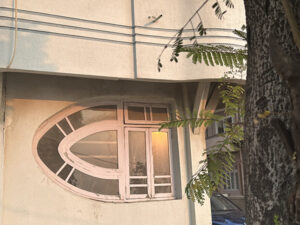
Still, Marine Drive isn’t only a residential district. Within five minutes of the hotel, we could walk to a few shops and banks, some more colleges, a nearby train station, Churchgate. Two blocks away was Veer Nariman Road, which has a few hotels, including the Ambassador with its splendid turret that used to rotate; several good restaurants including an Asian fusion spot, Foo, where I had dinner three times; and a beloved ice cream parlor called Rustom’s that I regretfully missed. The most famous hotspot off Marine Drive might very well be Brabourne Stadium, which was bustling and creating its own street scene during two World Cup cricket qualifying matches held there during early November. One night we came into the hotel to find excited guests in the lobby with faces painted supporting the Indian cricket team. Victory!
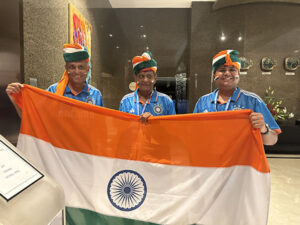
Because he was truly on vacation, Tony got to enjoy more time in Churchgate than I did. I’d come to Mumbai for meetings and site research. My days in Mumbai were filled with drives to various parts of South Bombay and its near suburbs for book research, and out farther on some days to places like Santa Cruz and Chemmur to meet film executives interested in The Widows of Malabar Hill. All very exciting, but more hours were spent in the car than the offices. I never had imagined that one could get sciatica from just being a car passenger, but it happened to me. The pleasant company of Mr. Sonu Rekhi, the outspoken and friendly driver who transported me during these eight days, was diverting.
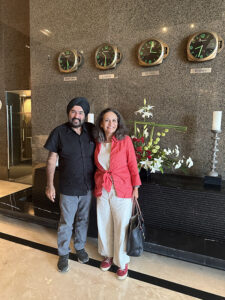
The first day I traveled for Bollywood purposes, Sonu and I set off at eight a.m., arriving at ten-thirty for an eleven o’clock meeting. I didn’t return to my hotel until eight, and that was only because my agent kindly postponed the day’s last meeting. But as I left the darkness of Marine Drive and stepped into my hotel room, the telephone on my desk trilled.
The hotel concierge was on the line, asking if I would accept a free in-room massage. Was I hearing that right? I learned that a brother-sister team of massage therapists would be willing to give both me and my husband head and foot massages. Of course I said yes, and half an hour later, my head and my toes felt as if they had been reborn. A lasting connection was made; as I spent my days doing interviews, my husband made sure to book a (paid) massage for himself with the Massage Brother almost every day (in between his walks and museum-going). We came to really know and like the hotel staff, and it was quite easy to get acquainted with familiar with people who knew our favorite table and our coffee styles.
Over the years, I’ve stayed in a few different places in Mumbai’s neighborhoods. These spots have included a family home, a private club, an Airbnb, and three different hotels. All of these experiences have offered their own special opportunities. This particular stay became all the sweeter because my friend Sifra, a historian who helped me with my last book, lives with her husband in the art deco apartment building closest to the hotel. Sometimes, when I was awake early in the morning at the writing desk, I’d look out my window toward her apartment building to see if her lights were on yet. Sifra could step over at a moment’s notice for a breakfast meeting, and we could arrive to her flat speedily, too. And it was this surprise proximity that made our friendship deepen and Churchgate feel like home.
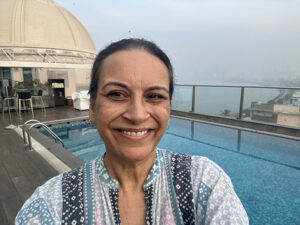
The post Marine Driven appeared first on Sujata Massey.
November 29, 2023
Held Up in Fort Cochin
This post originally appeared on Murder Is Everywhere.

It feels like only yesterday that I was driving out of Kumarakom Village, in the Kottayam district near Lake Vembanad. That’s how much of lasting impact the gorgeous, green state of Kerala in South India has, even on my fifth visit.
From Kumarakom, it was 53 kilometers north to Kochi, with its historic port district still called Fort Cochin. Originally, this port town was part of the kingdom of Kochi, but in 1503, the territory was gifted by Kochi’s Rajah to the Portuguese who’d provided military support in war with a neighboring ruler. The Portuguese lost Kochi to Dutch colonizers in 1663, and then in 1814, the Dutch decided to swap the region with the British for a larger prize: Malaya.
Our driver knew the freeway was packed with traffic that Saturday, so he took us on scenic byways through little villages, where we saw people shopping at stands like this one. I had tasted a few varieties of bananas while staying at Kumarakom Lake Resort, but passing by these fruit vendors I heard that there are close to 100 varieties growing in Kerala. The banana is the state’s favorite fruit, and as I researched Kerala bananas later, I learned that unfortunately 25 to 40 percent of the crop is lost each year due to insufficient storage. It reminds me of what I’ve heard about the high food waste per household in the United States. But oh, how much I’d rather eat the tiny sweet bananas of Kerala, which can be sautéed, boiled, and also turned into snacking chips.

It was a pleasant hour-and-a-half journey to Fort Cochin, a district that seemed more densely packed with tourists than I remembered from my previous visits. Late October was still monsoon weather, meaning a torrential downpour of at least 90 minutes around 6 pm, but there were umbrellas in the lobby at Forte Kochi, our small hotel on Princess Street. And yes, there were plenty of bananas every day at the breakfast buffet.


This particular hotel was originally a grand 19th century house built by the Dutch that later became the home of a prominent Jewish merchant family. This family added a mikvah in the courtyard. Colors are bright, from the stucco to the tiled stairs, and the spiral ironwork stairs are typical for Fort Cochin.
The ritual bath is still preserved, albeit with a guarding chain to keep guests from wandering down the steps into very murky water.
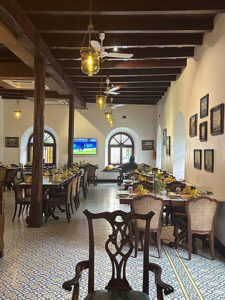
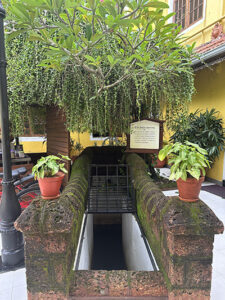
At present, the hotel is owned by a Kerala-based hotelier with a Christian name—Paul John. That name and the multicultural staff we met everywhere in Kochi reflect the diversity of many cultures living together peacefully for centuries–from the Dravidian people who had been the first known occupiers of the land that later hosted both Muslim and Hindu kingdoms, as well as the Protestant and Catholic Christian Indians whose ancestors had settled here before Christianity had arrived in Europe. Then there were Middle Eastern immigrants including Muslim traders and Jewish sailors. A beautifully preserved synagogue still stands in Fort Cochin, although the Jewish population in all of Kerala is said to have reduced to just fifteen people.
To deeply engage with Kerala’s history means reading. I was delighted to see that right around the corner from the hotel was an independent bookstore in a historic house called Idiom. Inside Idiom’s cozy ground floor, I found many shelves of old and new books, with a special focus on history and culture of the area.
I’d been trying to remember the title of a highly-praised nonfiction book about Travancore’s famous maharanis, and Thushara, the co-owner, helped me find it: Manu Pillai’s book, The Ivory Throne: Chronicles of Travancore. I also couldn’t resist Aliyah, The Last Jew in the Village, a historical novel originally written in Malayalam by Sethu.

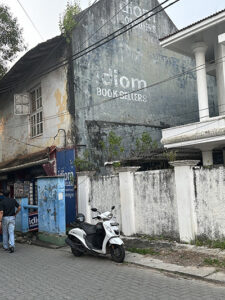
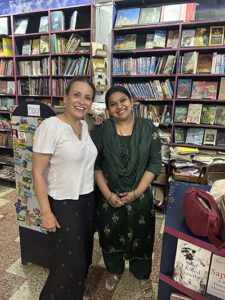
Book-buying was followed by an afternoon pause to let the rain arrive, have its way with the town, and then subside. It was time to walk to dinner at a delightful restaurant, Fusion Bay. But conversation inside the restaurant was overwhelmed for twenty minutes by the loud sound of fireworks, traffic and beating drums. We hurried outside to join the throngs of people watching a parade that included everyone from men on motorcycles to nuns. An image of Jesus was carried aloft, and we suddenly realized it was All Saints Day, and this was likely a church parade delayed a bit by the monsoon rain.

The next morning, we went for a pre-breakfast walking tour with an excellent local guide. He explained the colorful paintings on some of the old house walls were part of one of Kochi’s past Biennale expositions of international art. It’s not clear if the Biennale will continue, due to financial constraints, but the art will endure. We also walked to the area where local men still catch fish using gigantic fishing nets, and through old parks and residential district with more eye-candy houses.

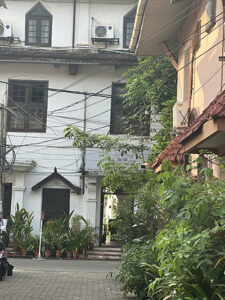
We left Fort Cochin that afternoon to visit to the nearby city of Ernakalum in order to lose a few hours at the Kerala Folklore Museum. Started by the late George Thaliath and continued by his wife and children, this museum holds thousands of objects, large and small, ranging from temple statuary to paintings and poison-testing dishes used in old royal courts. The vast scope household and temple artifacts and art of various periods made the immensity of Kerala’s history almost overpowering. Perhaps because my head is stuck in the 1920s, I zoomed in on a painting of a lovely young aristocratic woman in painting from that time. The museum also has a lovely gift shop like I’ve never seen that sells antique and modern crafts, and artisan-made textiles and jewelry.
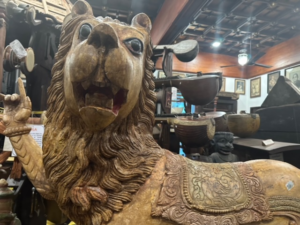
My time for Fort Cochin was just two nights, but Air India complications with a five-times-delayed flight from the Kochi Airport meant that we almost didn’t leave. I had the same experience with a much-delayed Air India flight from Cochin twenty-six years ago, and that delay lasted six days! It’s one thing to hole up in a nice hotel room when it rains, but nobody wants to be held up for more than 18 hours when other airlines are running flights to the same place. Therefore, after a few hours, we gave up on Air India and booked on Indigo for a 2 am flight to Mumbai. As frustrating as the situation was, there was something adventurous about flying in the middle of the night from a mostly deserted airport terminal. And then, before the sun had risen, we had reached Mumbai.
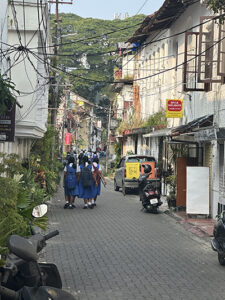
The post Held Up in Fort Cochin appeared first on Sujata Massey.
November 15, 2023
Retreat to Kerala
This post originally appeared on Murder Is Everywhere.

I’ve just returned from two weeks in India, utterly tired but happy to have gone. It’s interesting that while I have lingering jet lag for a week on this end, I felt only a little tired during first two days of my time there. Perhaps because Kerala is magic!
This will be the first of a few posts sharing pictures of the places we stayed. Wanting to rejuvenate after a long flight with a layover in the Middle East, we landed in Kerala on a Thursday evening and got in the resort’s chauffeured car onward to the resort—something much more chi-chi than my usual travel practices.
We stayed at Kumarakom Lake Resort, which is set along Lake Vembanad, a giant lake in the Backwaters area. We were surprised to learn that King Charles and Camilla stayed in the largest set of villas when he was celebrating his 65th birthday. The resort is owned by a local Kerala family, rather than a chain, and the personal touch showed everywhere. One of the things I liked best is how many of the buildings were made up of pieces and whole original historic dwellings that might otherwise have been lost to time.


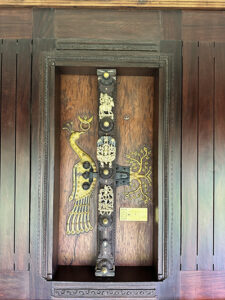
Kerala is famous for houseboat tourism, wherein people eat, sleep and lounge on boats that slowly are pulled through the backwaters. This time, I was in the mood to see the houseboats drift along, but I had no interest in doing more than a short sunset cruise. We only had two days at the resort, and I didn’t want to miss out on sleep, swimming, yoga, and Ayurvedic massage. We were visiting on the tail end of Kerala’s lengthy summer monsoon, and humidity was high, even when the sun was shining.
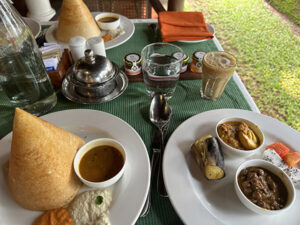
The restaurant was excellent. That’s not a yellow hat, but a dosa, the famous South Indian crepe.
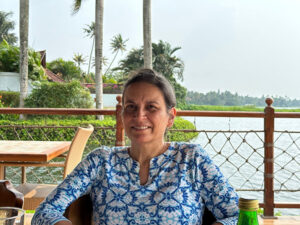
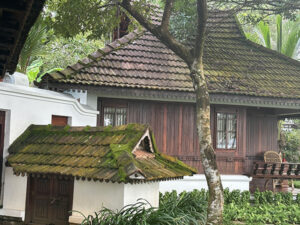
Our historic wood and clay tile villa—the little house is for the air conditioner’s compressor equipment.
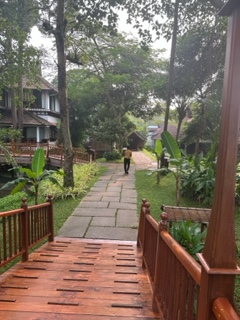
Small bridges connected the resort across streams that were home to many ducks and other waterfowl.
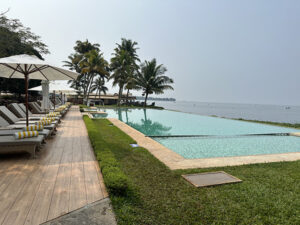
The pool was on the edge of infinity, overlooking the backwaters.

Every night it got cloudy, and then the skies would break open with rain.


And then, on a Saturday, we regretfully got back in the car for a long journey along the lake and back to urbanity. Next stop: Fort Kochi!
The post Retreat to Kerala appeared first on Sujata Massey.
October 5, 2023
Literary Lewes
This post originally appeared on Murder Is Everywhere.
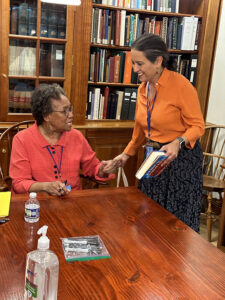 Cheryl Head signs her book for me
Cheryl Head signs her book for meLast weekend, I packed my bags and headed to the beach at Lewes, Delaware. The weekend promised to be overcast, but that was no big deal: I was planning to spend my time in a library and museum. My kind of activities, but spent with hundreds of others who love history.
History is the raison d’être for the Literary Book Festival held last weekend in Lewes. It’s the perfect setting, for starters. Lewes is the first town established in Delaware, which happens to be the first state signed up for the brand-new United States of America. It’s a sweet beach town with a past as a hub for fish canning. Although the houses were charming, the smell in the air was not so much.
As that industry dwindled, the choice of what to do next concerned the locals. While Lewes almost became an oil refinery town, more people preferred to concentrate on tourism. This choice secured the safety of the sweet wooden Victorian cottages everywhere and raised real estate values, because many people from the eastern seaboard have come to retire here. And where retired people go, libraries must be strong. The History Book Festival—said to be the only such celebration in the United States—is a joint project of community organizations, the public library, and two bookstores, Biblion in Lewes and Browseabout in Rehoboth. The festival features both historical nonfiction and fiction, a surefire way to meet almost everyone’s taste. Although most of the people present were from Delaware, those of us at the festival from other states were thrilled by the small size and beautiful atmosphere of the town.
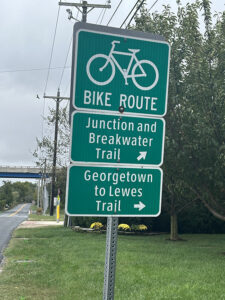
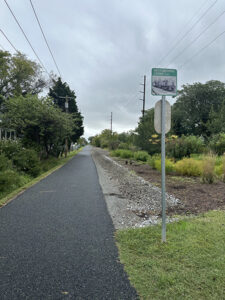
I’ve been a featured author before, and this year I was invited to put on my old journalist hat and do some interviewing. I sat with the highly successful young author, Lev AC Rosen, and he captivated us with tales of the secrets of GLBTQ life during the 1950s in San Francisco, which for a brief time had a thriving club scene, only to be shut down my Eugene McCarthy’s witch-hunts. To paraphrase Lev, being gay in those days was like living in a film noir episode, because around every corner, danger was lurking; nobody could be trusted. Lev’s forthcoming book, Bell in the Fog, continues the adventures of Andy Mills, the private detective introduced in his first book set in 1950s San Francisco, Lavender House.
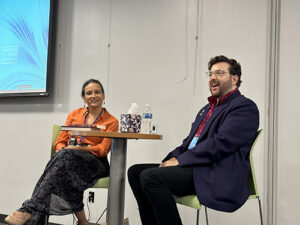 Interviewing Lev Rosen
Interviewing Lev RosenThe festival opened with a talk about how Abraham Lincoln skillfully created bonds with people with whom he had significantly different beliefs—and the positive outcomes that occurred due to empathy and trust. Steve Inskeep, the host of “All Things Considered,” talked with Christina Thompson Schutt, the director of the Abraham Lincoln Residential Library Museum in Springfield, IL. Steve’s new book about Lincoln is called Differ We Must. Both of them had stories from history that greatly expanded the existing image of the sober-seeming president who ended slavery in the United States.
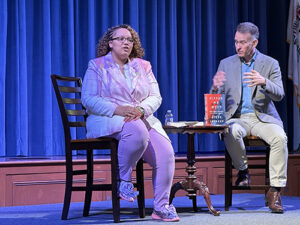
James McBride, the National Book Award winning author, was one of the festival’s brightest stars. He signed copies of his newest book, The Heaven and Earth Grocery Store, and spoke to a crowd of 700 festival-goers at the local high school auditorium.
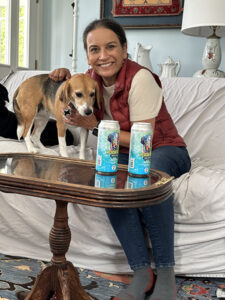
I was fortunate to be a spectator at Cheryl Head’s well-attended talk about her recent novel, Time’s Undoing, which fictionalizes a true unsolved crime in her own family’s history. The crowd was riveted as they heard her read a portion of her book that was thick with suspense, and she also shared terrific photographs from her grandparents’ days in 1920s Birmingham, Alabama.
With multiple talks going on at different venues, it was hard to decide where to prioritize. And Lewes was calling, with its beautiful walking and cycling trail. I made time for a quiet stroll by myself, and as if in sympathy, the rain held off.
Most authors stayed in hotel rooms provided by the festival, but I was lucky to stay with my friend, a festival volunteer and former high school history teacher, Tammy Chincheck. Tammy has a beautiful 19th- century cottage surrounded by flower gardens. One of her dogs, a beagle named Cricket, was rescued from several years of life in a cage in a facility that bred dogs for research. Cricket was so happy and sociable—and like many beagles, utterly focused on food. Cricket’s face was chosen for the dog image on the can for Rescue Ale, a small batch pale ale made by Solace Brewery in Northern Virginia.
Dogs, friends, walking, and books! What could make a better weekend?
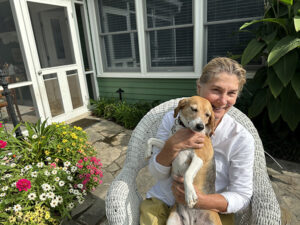
The post Literary Lewes appeared first on Sujata Massey.
September 20, 2023
Writers on the Farm
This post originally appeared on Murder Is Everywhere.
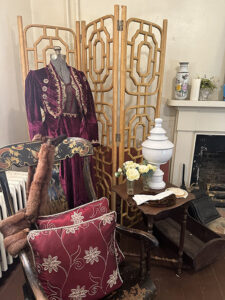
Near my childhood home in St. Paul, Minnesota, you’ll find the Gibbs Farm, a historic farm homestead dating from the 1850s which includes a one room schoolhouse, barn, and household—all of it filled with a miscellany of pioneer life. Old books, clothing, toys, farm equipment, and household furnishings enchanted me. During the summer I was nine, I “volunteered” at Gibbs Farm, walking over daily and doing small tasks the docent staff kindly gave me. I wished I’d been born a hundred years earlier, and by spending days at Gibbs Farm, I pretended that this was true.
 Gibbs Farm, Falcon Heights, MN
Gibbs Farm, Falcon Heights, MNGibbs Farm nostalgia returned last weekend when I visited a late 1700s farmhouse called Linthicum Walks. The clapboard house is sited in the Anne Arundel, Maryland town of Crofton, where a Welsh immigrant family, the Linthicums, farmed for more than 200 years on a large parcel of land originally purchased in the 1700s. Today, a small graveyard exists, as well as a barn and the original 1700s farmhouse which was built on through the 1920s.
 Linthicum Walks, Crofton, MD
Linthicum Walks, Crofton, MD

Development surged in Anne Arundel County in the 20th century. Now the small gravel driveway into the Linthicum Walks acreage intersects busy Maryland State Highway 424. Linthicum Walks is flanked by public middle and high schools on either side. Still, because of the tall trees, it remains a private sanctuary.
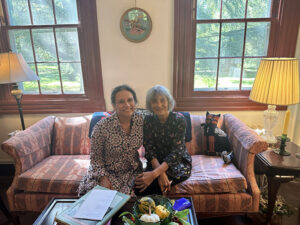
Today Linthicum Walks is managed by a board of trustees endeavoring to bring the local community to enliven the house. The board first invited Marcia Talley, an Anne Arundel County writer, to speak about mystery writing. Marcia generously invited me. So in short order, the two old friends got to chatting with a group of women from Maryland and Virginia in the home’s cozy colonial parlor. Sitting comfortably in a pair of wing chairs, Marcia and I had a signing that really doesn’t compare to any other event we had. It felt like going back in time to a social hour in an enchanting atmosphere. Sunlight streamed through small old-fashioned windows; patinated wooden cabinets were filled with vintage fine china; and original fireplaces were surrounded by fox hunting prints and paintings.

Marcia and I talked about mystery; how we both treasure writing books that are low on violence and high on character and setting. The readers wanted to know about the kind of research we did. Marcia has spent many hours in Maryland graveyards and doing genealogical research that has enriched her Hannah Ives mystery series. I lose myself in libraries such as the Ames at the University of Minnesota that have rare historical source materials. It was heartwarming to be among a group of readers who treasured history while being open to new stories. A board member of Linthicum Walks told us about a library in Maryland we needed to visit that had a strong collection of historical records.
After the book talk, I tiptoed up a narrow staircase and explored three more rooms. One was a sleeping porch, now closed in, from the twentieth century and still furnished like an old-fashioned bedroom. The second room was a nursery bursting with toys and oddities. The other original bedroom contained a melange of antiques, among them a gilded purple velvet gown that somebody’s great aunt is said to have worn to a Presidential inauguration.
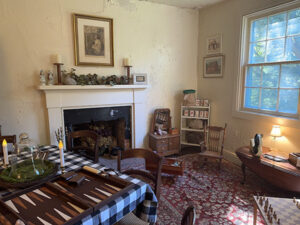

That’s the thing about historic house museums. The stories behind treasures are often orally transmitted legends. Rooms rarely hold furniture that completely belonged to the family, or shows the same time period. There are no little signs that tell you the age and provenance of items, but there’s a lot of amusement to be had when poring over vintage boots, empty tins of Hershey’s cocoa, and samplers embroidered by children. However, there is information galore about the families who lived for generations in one place.
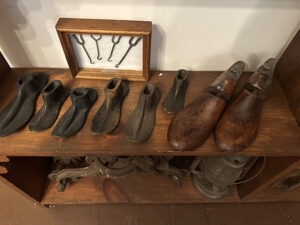

Volunteer gardeners planted several lovely beds of flowers and shrubs outside that attract local pollinators. I spotted a proud-looking beehive, and a cozy squirrel house. And as I regretfully left Linthicum Walks, the air stirring through the trees whispered: “come on back.”


The post Writers on the Farm appeared first on Sujata Massey.
September 6, 2023
The Name Game
This post originally appeared on .

At birth, we are given a name that’s not our choice, but that of our parents or guardians. It also can happen on a macro-level when you think of the names of countries. And when we understand how people outside the home react to our name—our self-image develops.
The Prime Minister of India and members of his ruling political party, the Bharatiya Janata Party, have recently begun referring to India as Bharat. Hindu Nationalists believe Bharat is the Sanskrit-based name for the subcontinent and that using it officially removes the imprint of colonizer’s language, much as changing city names has done. Yet Bharat is a word that comes out of Hindu history, and not everyone in India is a Hindu. Such a name change, if it’s more than temporary, will have a bearing on how citizens feel about their homeland.
I grew up with an Indian name that can be pronounced correctly if you follow the English sounds of the letters: Sue-JAH-tah. Still, my six-letter name was confounding to many people as I grew up. During my school years in suburban Minnesota, teachers would stop dead when my name showed up on the classroom roll. Snickers from kids followed as the teacher mispronounced my name, or just looked toward me—usually the only brown kid in the room—and said “I can’t pronounce this.” Kids twisted my name into their own grotesque teasing adaptations. Adults often said, “Can I just call you Sue? or even “I’m going to call you Sue.”
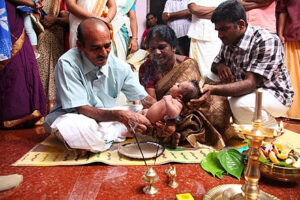 Baby Naming Ceremony in Kerala
Baby Naming Ceremony in KeralaIndians often ask me whether my father chose my name because of a famous 1959 Bimal Roy movie called Sujata. Starring the actress Nutan, the film tells a love story that almost tanks because of caste discrimination. My father did see the film, but that wasn’t how the name came into his heart. Instead, the Sujata he knew was an older, very bright student at his high school who became a close friend to him and another boy, offering them advice on their academic pursuits and life. Sujata and my father corresponded by letter during their early years at separate colleges. One day, Sujata wrote to say that she was engaged. Out of propriety, my father never wrote to her again. Yet his sentimentality led him to suggest the name to my German mother. She agreed—slipping in one of her family’s traditionally passed-down names, Christine, for my middle name. Both of my younger sisters have one Eastern name and one Western name; sometimes the order is mixed up, but both names are there, proudly bicultural.
When I reached Baltimore for college, I didn’t have the same kind of trouble with people balking at my name. The undergraduate mix at Johns Hopkins was highly international with lots of classmates having names that reflected their unique heritage, or their parents’ imaginations. I began relaxing into my own name and didn’t feel like it was a burden. But as I left academe to become a reporter in a ‘real world’ city, it seemed many people I rang up for interviews could master either my first or last name—but not both. And this made me feel different again.
I married in the early 1990s, an era in which about half of professional women retained their maiden names, and the rest either hyphenated or assumed the husband’s surname. I chose to say goodbye to Banerjee and adopted Massey. My husband didn’t ask me to do it, but I was thinking ahead to the future… my byline on a book jacket! I felt that having a name that couldn’t be pigeon-holed to one country gave me more psychic freedom to write about a lot of places.
I did write about many places. But ironically, I discovered that to many in India, Massey is an Indian name—and Indians care a lot about what names mean. I’ve had many situations wherein Indians have asked if I’m a Punjabi or married to an Indian Christian, or Anglo-Indian. There are journalists who even explored this issue in print.
“Masseys are buried here! They are in town! Who are your relatives?” the Anglo-Indian caretaker of the South Park Street Cemetery in Kolkata asked with great excitement when I visited. He refused to believe I could not be related—and perhaps a few of my husband’s British ancestors did sail for India.
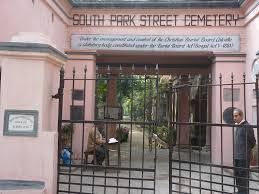
The space where I have the most fun thinking about names is while writing fiction. My first series was set in Japan. Just like India, Japanese names translated to English are spelled phonetically. Names like Ito and Taro and Shimura didn’t cause too many stumbles. My female protagonist is named Rei. Its pronunciation, “like a ray of light” was explained in the book by the character. And of course a sleuth shines light on crime! The name Rei has multiple meanings in Japan depending on which kanji character is used to express it. The meaning I chose for my character Rei was crystal clarity, which also is synonymous with her role.
For my books set in India, I found myself suddenly writing huge casts of characters, all of whom demanded unique names. I also wanted readers new to these names to be able to keep track of them in their mind. I turned to a book that I’d originally bought to name my own future children. It is titled Pick a Pretty Indian Name for Your Baby. The book’s authors, Meenal Atul Pandya and Rashmee Pandya-Bhanot, present names that they think are less likely to be mispronounced or translate poorly, with examples given in the introduction like Viral and Naval (I have used Naval in fiction without incident!). Another aspect I like about this book is the meaning listed next to each name. Thus, I selected the name Oshadhi, which means medicine, for a character who’s an unofficial family pharmacist.
I also find character names as I encounter them in real life. I met a lovely lady called Sunanda (the name means ‘beauty’) who was the head of housekeeping at the Royal Bombay Yacht Club. Every time we passed each other in the building, Sunanda greeted me with confidence, and I saw what pride and responsibility she took in her work. I gave her name to a young woman character with incredible courage and heart.
The Parsi people are followers of the Zoroastrian religion who emigrated to India up to a thousand years ago. Parsis typically have Persian or Western first names, and last names that relate to a place or occupation. These surnames can be gloriously specific, like Sodabottlewalla or Engineer or Banker. Quite a few Parsi names start with the letters Z or X, memorable letters that tempt me toward literary use. However, the historian Dinyar Patel pointed out that very few Z names existed before the mid-twentieth century. Sighing to myself, I held back on the Zs, although I am happy to have a male character called Xerxes.
The heroine of my series is Perveen Mistry, a young Parsi woman whose surname means construction, the line of business her ancestors started with. The name Perveen is means ‘star’ which I think is excellent for someone who features in book after book. Amongst Parsis, Pervin and Parveen are alternate spellings.
I was looking for a good heroine’s name back in 2015 when I was working on a book proposal. I had no idea what I would choose, so I went online looking at lists of Parsi female names. When I saw Perveen, a happy memory came back to me. Around the age of ten, I’d devoured a wonderful historical juvenile novel titled Parveen by Anne Sinclair Mehdevi. The novel was about a 16-year-old Persian-American who has a life-changing adventure visiting her divorced father in Persia. The novel takes place in 1921, an eerie symmetry with my own series, which I chose to start in 1921 Bombay.
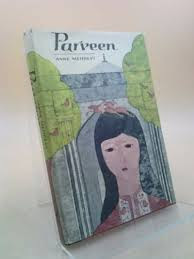
Recently, I searched used book websites to find an image of the 1969 book Parveen. Very few copies still exist, and I’m ecstatic that one of them is on its way toward my home, at quite a reasonable price. After Parveen arrives, I can nestle her next to my own Perveen: books written more than fifty years apart yet linked in my literary imagination.
The post appeared first on Sujata Massey.
August 23, 2023
Tomatoes for Two
This post originally appeared on Murder Is Everywhere.
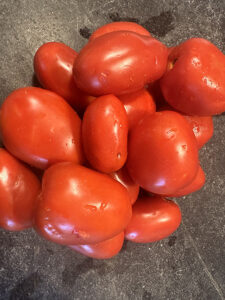
It’s entirely possible to buy tomatoes in many parts of the world without being able to speak the language. In Spanish and German, it’s called a tomate. In Hindi, they say tamaatar, and in Gujarati, tamota. In Turkish, domades.
There seems to be one theme emerging, but there’s a second linguistic direction followed by those who speak romance languages. The French named the tomato pomme d’amour (love apple). The aphrodisiac philosphy carries over to the name pomidor in Russian and pomodoro in Italian.
I was born in England so I used to say toe-mah-toe, but now that I’m in the US it’s toe-may-toe. Doesn’t sound as romantic, but I do believe tomatoes are the binder of happy meals and marriages.
Last Sunday, my husband Tony and I agreed it would be a good idea to buy 30 pounds of Roma tomatoes at the farmers market in order to stock up for the fall and winter.
I actually only needed about five pounds of tomatoes to make a highly spiced Indian tomato chutney.

On the other hand, Tony needed a huge amount. He wanted to make a few gallons of a pureed tomato, garlic and onion sauce that could be a base for many dishes. He’s been making this sauce for us for years and ensures a good store for most of the year by carefully pouring 2-cup quantities and freezing them. But now that he’s got his own vacuum-sealing equipment, he could do it in air-tight blocks to be stored in our large standing freezer (another recent husband purchase).
I don’t know if you are getting the dynamic of our 31-year-marriage yet, but it involves what you might call differences of opinion.
Two people, two tomato-buying expeditions ensued. On a Friday, I bought 5 pounds of Roma tomatoes from a roadside farm stand. On Sunday, when we went to the Baltimore Farmers Market, where I found the only farmer selling bushels and larger of tomatoes, including Romas, which everyone knows are the preferred sauce-making tomato due to their lower level of water content. I paid for the beauties, and Tony lugged a 25-lb cardboard box packed with Romas to our car. When he got home, he located the cotton gloves he’d wear under vinyl gloves to protect his hands from slipper tomato juice, and he located the vacuum sealing machine and roll of heavy-duty freezer plastic. The knives came out, and operation tomato sauce was underway.
At the start of marriage in our twenties, I’d have been at Tony’s side helping him blanch a few hundred Roma tomatoes in lightly simmering water, and then deseed, as well as the eye-watering task of chopping onions. But Tony’s cooking style is longer and more perfectionist than mine, so I’ve leave him to cook some dishes undisturbed.

When his sauce was on its first simmer (yes, it gets cooked twice!) and all his rigamarole was in the dishwasher, I returned to the kitchen to start prepping. My recipe was a lot simpler, and I had many fewer tomatoes to chop. Still, I had to do some math to calculate the right amount of vinegar and sugar and garlic and ginger to use. Just slivering the fresh ginger and garlic took me an hour and a half.

I am always looking for shortcuts, so I decided to try simmering my chutney in a slow cooker. After a night’s cooking on low, I was disappointed that the temperature was just a bit too low for the chutney to thicken. So, I poured the warm mixture of tomatoes, spices and vinegar into a ceramic-coated Dutch oven, and after I brought it to ha happy boil, I lowered the temperature to simmer and partially covered the pot. About four hours later, the red chunks swimming in vinegar had reduced by half into a rich reddish brown, sticky concoction. I added just a tiny bit more sugar and salt to taste, and the chutney was ready to cool in the fridge.

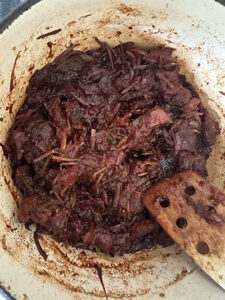
At the end of our tomato weekend, the kitchen smelled of vinegar and garlic, and we were happily exhausted. Both tomato recipes are listed on my website. Tony’s sauce is European, and my chutney is Indian, but we are united as a couple who will share these savory tastes over the upcoming six months.
Here’s what one can do with a simple tomato-onion-garlic sauce:
Add Italian herbs and make a marinara sauceAdd ground meat and make it a raguAdd cumin and chilies and other ingredients to make a Middle Eastern, Mexican or Indian gravy to blanket a baked dish or curryAdd milk or cream to make cream of tomato soupHere are some ways to use a tomato chutney:
Serve it as an accompaniment to a classic Indian mealAdd it to a cheese, vegetable or chicken sandwichServe it with grilled meat or fishPeel hardboiled eggs, split them, and put a dash of chutney down the middleBon Appetit!
The post Tomatoes for Two appeared first on Sujata Massey.



